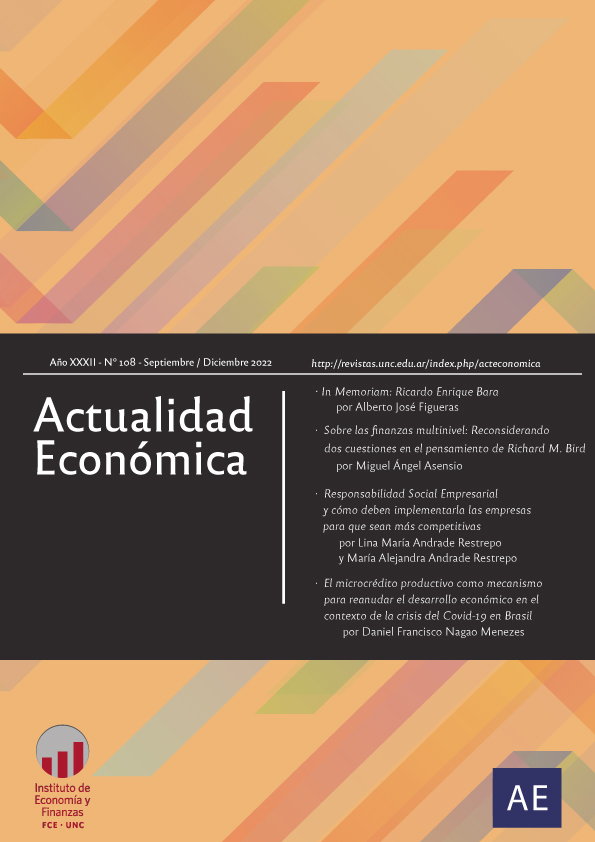Productive microcredit as a mechanism to resume economic development in the context of the Covid-19 crisis in Brazil
Keywords:
Productive microcredit, Development, COVID-19, BrazilAbstract
The article seeks to analyze the supply of microcredit and whether it positively favors the resumption of the economy in the "pandemic scenario", with the generation of employment and income and, consequently, the socioeconomic development of the country. To do this, it reviews the composition of microcredit in the National Financial System, reporting on the political experiences of microcredit in the Brazilian and international scenario, and its role for productive activity after waves of pandemics. The conclusion of the research is that it favors the rapid recovery of the Brazilian economy, with an increase in the level of production, job creation, income and consumption, and that the effects spread in the short term, and are consolidated in the medium and in the long term. However, it is understood, given the current context, that the Federal Government has adopted generalist policies, acting indirectly, instead of acting directly in the sectors most affected, so that the measures adopted show timid results contrary to what was expected by government. market at the beginning of the pandemic.
Downloads
References
Alves, S. da Silva; Soares, M. M.. (2004) Democratização do crédito no Brasil: atuação do Banco Central. Disponible: https://www.bcb.gov.br/htms/public/microcredito/democrat.pdf
Banco Central do Brasil. Indicadores Econômicos. Disponible: https://www.bcb.gov.br/estatisticas/indicadoresselecionados.
Banco Central do Brasil. Resolução 2.874 de 26 de julho de 2001.
Banco Central do Brasil. Resolução n. 3.109 de 23 de julho de 2003.
Bonavides, P. (2012) Curso de Direito Constitucional. 27ª ed. São Paulo: Malheiros.
Brasil. Constituição da República Federativa do Brasil de 05 de outubro de 1988.
Brasil. Lei nº 4.505 de 31 de dezembro de 1964.
Brasil. Lei nº 9.790 de 23 de março de 1999.
Brasil. Lei nº 10.194 de 14 de fevereiro de 2001.
Brasil. Lei nº 11.524 de setembro de 2007.
Brasil. Lei nº 13.999 de 18 de maio de 2020.
Brasil. Medida Provisória nº 122 de 25 de julho de 2003.
Brasil. Medida Provisória nº 992 de 16 de julho de 2020.
Costa, F. Nogueira da. (2010). Microcrédito no Brasil. Disponible: https://www.eco.unicamp.br/images/arquivos/artigos/1805/texto175.pdf.
Deangelo, J. (2005) Microfinanças: contorno e ambiguidades da regulação brasileira. Revista de Direito Bancário e do Mercado de Capitais. v. 30. ano 8, p.224.
Fundação Getúlio Vargas Projetos. (2020). Atualização de estudo sobre participação de micro e pequenas empresas na economia nacional. Recuperado do SEBRAE. Disponible: http://datasebrae.com.br/wp-content/uploads/2020/04/Relat%C3%B3rioParticipa%C3%A7%C3%A3o-mpe-pib-Na.pdf.
Martins, P. (2002). Regulamentação das microfinanças. Rio de Janeiro: BNDES.
Neri, M. (2008). Nanocrédito e combate a pobreza. In: Neri, Marcelo (ed.). Microcrédito, o mistério nordestino e o grameen brasileiro: perfil e performance dos clientes do CrediAmigo. Rio de Janeiro: Editora FGV.
Neri, M.; Buchmann, G. (2008). CrediAmigo: O Grameen tupiniquim. En: Neri, Marcelo (ed.). Microcrédito, o mistério nordestino e o Grameen brasileiro. Rio de Janeiro: Editora FGV.
Soares, M.M.; Melo Sobrinho A. Duarte de. (2008). Microfinanças. O Papel do Banco Central do Brasil e a Importância do Cooperativismo de Crédito. 2ª ed. Brasília: Banco Central do Brasil.
Downloads
Published
Issue
Section
License

This work is licensed under a Creative Commons Attribution-NonCommercial-NoDerivatives 4.0 International License.
Those authors who have published with this journal, accept the following terms:
Authors will conserve their copyright and guarantee the magazine the right of first publication of their work, which will be simultaneously subject to the Creative Commons Attribution-NonCommercial-NoDerivative 4.0 International License that allows third parties to share the work as long as the author and first publication of this magazine are indicated.
Authors may adopt other non-exclusive license agreements to distribute the published version of the work (e.g., deposit it in an institutional telematic archive or publish it in a monographic volume) provided that the initial publication in this journal is indicated.
Authors are allowed and encouraged to disseminate their work through the Internet (e.g., in institutional telematic archives or on their website) before and during the submission process, which may lead to interesting exchanges and increase citations of the published work. (See The effect of open access)









